|
Springsure
Revisited Alistair
Melzer September 2007
From 1989 to 1992 I undertook an intensive study of koalas and koala
habitat on Norwood Creek, west of Springsure and on Springsure Creek
at a site about 25 km east of Springsure. This study was undertaken
with the aid of community volunteers including those who eventually
set up the Central Queensland Koala Volunteers.
This month I revisited this study site for the first time in 15
years – and what a change there was! |
| Dead
riparian forest on Norwood Creek (September 2007) |
|
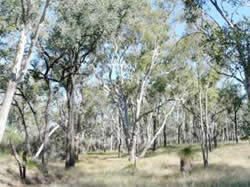 |
Carmen Drake,
Caroline LeBris and Maud Cloarec joined me on a weekend visit. The
intent of this essentially social trip was to assess the need for
a future resurvey of the koala population. We travelled the four
hours' drive from Rockhampton to Springsure and booked into the
Zamia Motel on Saturday morning. Carmen was the first local person
to volunteer her time to the koala study back in 1989. Maud and
Caroline are students from France on a work based training program.
They are here to pursue koala studies. That afternoon we familiarised
ourselves with the Minerva Hills National Park and my old study
site on Norwood Creek. We spent the afternoon searching in vain
for koalas. We did find koala signs (scratches, urine stains and
scratches on tree trunks) but no koalas. |
| Healthy
riparian forest elsewhere along Norwood Creek (September 2007) |
|
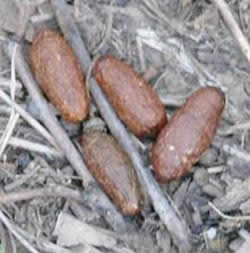 |
On Sunday we
spent the day in the park. Carmen, Maud and Caroline looked at the
habitat structure while I looked at the size classes of the Blue
Gum(Eucalyptus tereticotnis) and Moreton Bay Ash (Corymbia
tessellaris). All the while we kept an eye out for koalas. On
Monday morning we finished a few things at Norwook Creek before
having lunch on Springsure Creek along Arcturus Road. So
what did we find? Firstly
we could not find any koalas on Norwood Creek. We did find scattered
signs of koalas – droppings, scratches and urine stains on trees.
Koalas are present but at such a low density that diligent searching
by four people could not find any animals. |
| Fresh
koala faecal pellets on Norwood Creek (September 2007) |
|
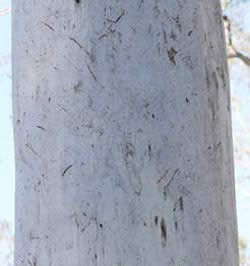 |
Secondly, the
koala habitat was in severe decline with many Blue Gum and a lesser
number of Moreton Bay Ash dead or dying. We presume that this is
due to drought although there were signs of an intense fire. Many
old Blue Gum, Moreton Bay Ash and iron barks (E. crebra,
E. melanophloia) had been burned out. At
Springsure Creek the situation was much the same with most Blue
Gums, many Moreton Bay Ash and some Coolibah dead or in very poor
conditions. Koala signs were sparse but after some systematic searching
we located two koalas – mature male and mature female. This is in
an area that formally held a population density of 40 koalas per
km2. Here drought seems to be the primary cause. There
was no indication of fire. Grazing pressure appeared moderate. |
| Koala
scratches on Blue Gum on Norwood Creek (September 2007) |
|
 |
So we’ll aim
to return to these Springsure sites and systematically resurvey
the sites previously surveyed in 1991. This will need a team of
at least five people for four working days.They will systematically
search for koalas and describe the current structure and composition
of the habitat.We are seeing similar die back of eucalypts on St
Bees Island. If this is the impact of climate change then we are
probably looking at a wide regional reduction in koala numbers and
permanent change in habitat structure and composition. |
| Carmen, Maud and Caroline measured 400 trees while assessing
koala habitat along Norwood Creek (September 2007) |
|
| |
|
 |
|
| Caroline and Maud taking in their first wild koala. |
Female koala along Springsure Creek(September
2007) |
| |
|
| Despite
the tree dieback and the impact of recent fire on Norwood Creek,
wildlife was abundant. We found scats of Brushtail possum, Greater
glider and koala. We saw Echidna, Grey kangaroo, Wallaroo, Whiptail
wallaby and Swamp wallaby. A dead Rufus bettong was found in the
hole left by the burnout of an old gum tree. Sulphur crested cockatoo,
Galah, Redwing parrot, Rainbow Lorikeet and Pale headed rosella
were competing for nesting hollows. A pair of Crested hawk worked
through the canopy. There were a few pairs of striped honeyeaters
feeding in the shrubs. Currawong, Apostle birds, Grey headed babblers,
Magpie, Peewee, Bronzewing and Crested pigeon all competed for space.
Channel Billed Cuckoo and Pheasant coucal provided the background
calls so evocative of central Queensland summers. |
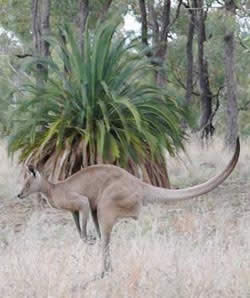 |
|
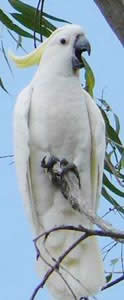 |
Sulphur Crested Cockatoo |
| St
Bees Island July 2007 |
The mature male established
itself in a way that blocked any escape by the younger male. It
maintained an erect posture and fed actively. (Photo A. Melzer) |
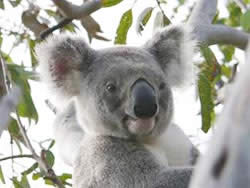 |
|
A young male koala from St Bees Island
July 2007 (Photo A. Melzer) |
At one stage the young
male attempted to crawl along the underside of the branch but
was driven back. Next morning both animals had left the tree and
were not seen again during the trip. (Photo
A. Melzer) |
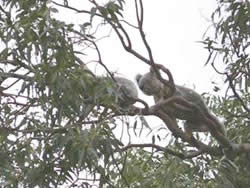 |
|
| A young male koala is pursued to the
outer branches of a 20 m gum tree by a mature male koala. There
was much grunting and bellowing from the mature male. (Photo A. Melzer) |
We watched
the young male remain clinging to the outer-most branches until
it was too dark to see the animals. (Photo A. Melzer) |
| |
|
|
Note
the difference in the chest gland between the two males. In the
older male the active gland and surrounding fur is stained brown
from the pungent secretions. The fur is white and the gland small
on the young male which is probably in its first year of sexual
maturity. The sternal gland is a secondary sex characteristic
in male koalas. |
|
Arts in the Park 2007
A really pleasant
day was spent in the Botanical Gardens on Sunday 14th
October under the banyan trees. The Koala Volunteers sold
hats, shirts, coffee mugs, stickers, orphan koalas and our
2008 Diary/Calendar. Thank you, Doreen, for helping on the
day.
We shared the
shade with Carmen and the Contemporary Artists display and
Ian and Cathy Herbert who were promoting Rhonda Melzer's
and Joel Plumb’s wonderful book on Plants of Capricornia.
Rhonda came along and personally signed all books sold.
Dawn
|
|
|
Twin Koalas
In
the Winter Edition of the newsletter there was a report about
the celebrations in China for the Twin koalas.
It
has been reported in 'That's Life', that twin koalas had been
born in The Ballarat Wildlife Park. There was a beautiful photo
of the twins with their mother.
I
contacted the magazine to get permission to print the article
in the newsletter and when I received no reply, I also contacted
the Wildlife Park, but was unsuccessful. If you can get a copy
of 'That's Life', you can read all about them.
I
just hope that these beautiful creatures survive.
Doreen |
From the Treasurer's Desk
Alistair is
arranging a meeting of members and science academics to
discuss where our funds could be directed for the best results
in Koala Research.
Our funds come
from various projects and each is important. Koala Chocs
and our Ugly Sweaters were the best fund raisers and the
diaries by our artist members, Carmen Drake, Dawn Pound,
Jo Lawrence and Rhonda Melzer have again been popular.Thank
you, members, for your support of our fund raisers and enjoy
the Festive Season.
Shirley
Hopkins |
|
|
Membership
Additional members
are urgently needed to spread the work load so if you have friends
who may be interested, please urge them to join.
Congratulations
to member Rhonda Melzer and co-author, Joel Plumb, who
have launched a wonderful book, 'Plants of Capricornia'. The
book features over 600 native species with magnificent photographs
and includes keys to species in each genus as well as human usage
and ecological notes. The book is available from:
Capricorn Conservation
Council, PO Box 4011,
Rockhampton 4700,
at a cost of $65.00 soft cover, $110.00 hard cover, postage and
handling -
Qld $12.00, other
states, $16.00.
Shirley
Hopkins |
| |
|

